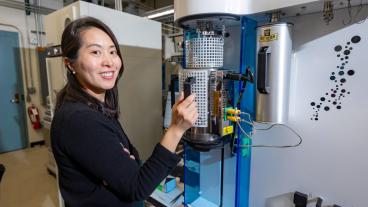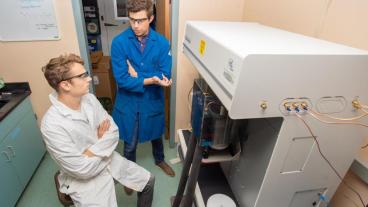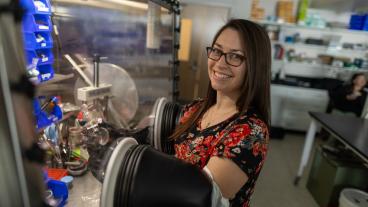Two Colorado School of Mines professors have received research funding through a U.S. Department of Energy program that encourages development of innovative solar power technologies.
Projects led by Sumit Agarwal, associate professor of chemical and biological engineering, and Alan Sellinger, associate professor of chemistry and materials science, were among the 48 chosen nationwide for a total of $46.2 million in funding under the SunShot Initiative. The awards were announced in July.
Agarwal received $225,000 to study degradation and regeneration in passivated emitter rear contact (PERC) cells, a type of silicon-based solar cell that is expected to become the leading solar technology over the next decade.
“These types of cells when they were first made, historically, when you put them out in sunlight, their efficiency degraded very quickly. More recently they’ve figured out a way to recover that efficiency,” Agarwal said. “It’s not clear what the process is at the atomistic level that leads to that recovery in efficiency.”
The research team will use advanced spectroscopic techniques to explore the defects in PERC cells, as well as assess the long-term stability of their regeneration. The work will be done in conjunction with Pauls Stradins at the National Renewable Energy Laboratory.
“It’s an important question—is this recovery in efficiency stable over the field lifetime of the cell?” Agarwal said. “Understanding it from the atomistic level can provide that answer.”
It’s the second SunShot grant Agarwal has received in a year—in September 2016, he also won a four-year $615,000 grant for developing a scalable and more cost-effective method of manufacturing ultra-high-efficiency solar cells, on which work continues.
Sellinger’s $192,529 award will fund work that aims to address the cost, efficiency and reliability of perovskite solar cells.
Perovskites are materials of a particular crystal structure that can be solution processed into highly efficient solar cells at a much lower cost than traditional technologies such as crystalline silicon and cadmium telluride. Their efficiency at converting light into electricity has improved dramatically over the past five years, now reaching commercially viable levels.
The one-year project will research new materials for the cells’ hole transport layer, generally the most expensive and relatively unstable component in the early-stage solar technology.
“This project will allow us to focus on making materials through simple synthetic processes, allowing for scale-up to multi-gram amounts that can be used to prepare larger-scale devices,” Sellinger said.
The grant will fund two people—one focused on synthesis and another, primarily stationed at NREL, fabricating devices with the in-house synthesized materials.
“In the future, it’s possible that this technology could be used for rooftop and/or building-integrated solar because it can be fabricated in a flexible format. For example, it can be rolled out and won’t require all the heavy framing that exists in current solar cell technology,” Sellinger said.
A program of the Office of Energy Efficiency & Renewable Energy, the SunShot Initiative is a national effort to lower the cost of solar electricity and encourage solar adoption. By 2030, the goal is to reduce the levelized cost of solar electricity to $0.03 per kilowatt hour for utility-scale photovoltaics.
CONTACT
Emilie Rusch, Public Information Specialist, Communications and Marketing | 303-273-3361 | erusch@mines.edu
Mark Ramirez, Managing Editor, Communications and Marketing | 303-273-3088 | ramirez@mines.edu



